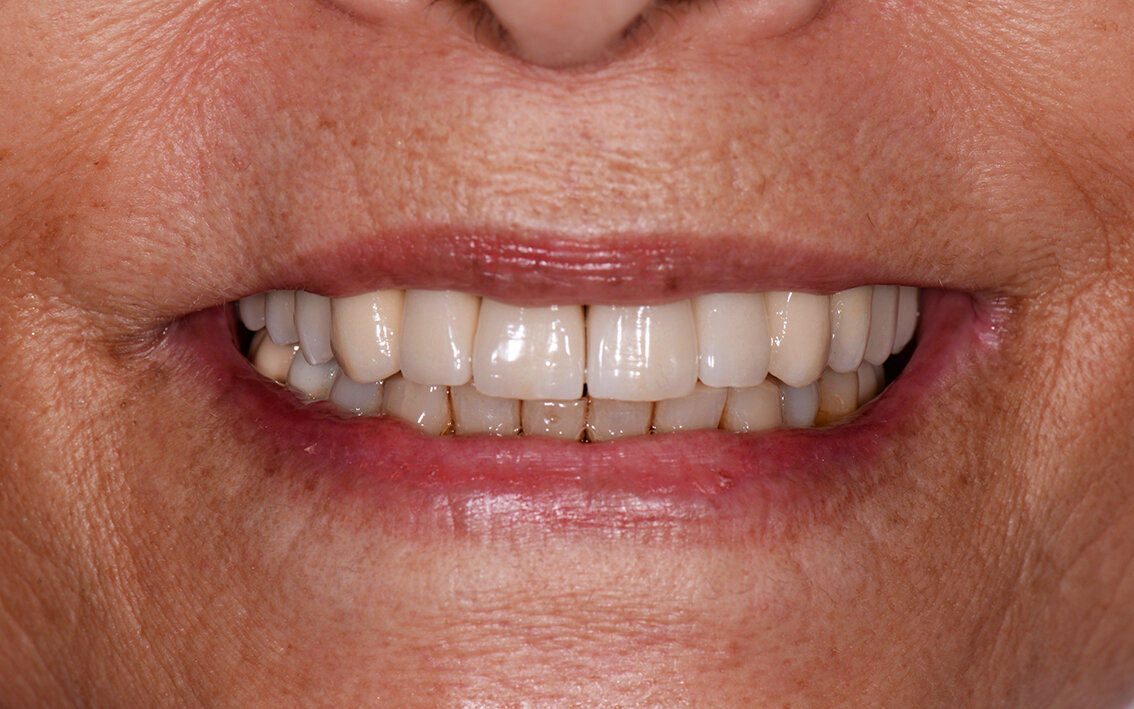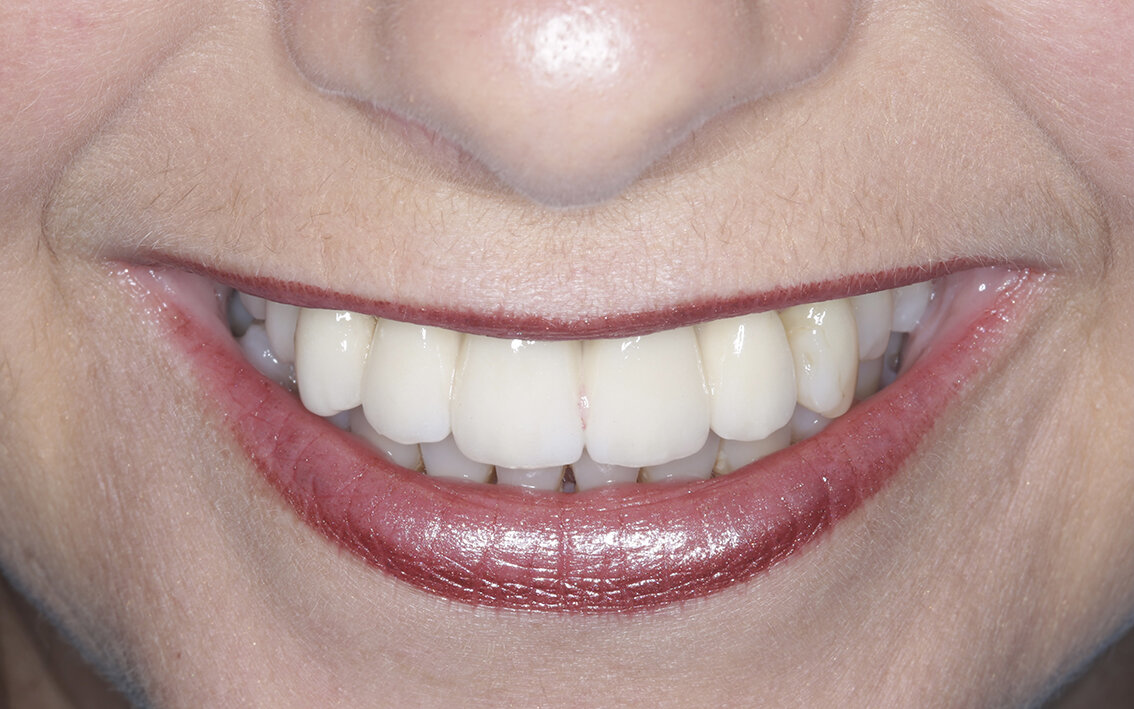What is a dental implant and how does it work?
Dental implants are one of the most incredible advances in modern dentistry. In simple terms, a dental implant is a “synthetic tooth-root”. Dental implants are made from medical-grade titanium alloys. They are generally 10-12mm in length and range from 3-5mm in width. They have a screw-hole in the centre which allows a crown, bridge or denture-attachment to fasten to the implant. As such, a dental implant can replace anything from a single tooth to a whole arch of teeth.
At Queensland Prosthodontics we only use reputed implant brands such as Straumann, Nobel Biocare and Dentsply-Astra and wherever possible, their associated genuine implant components for our restorations. All our prosthetics are made by premium Australian-based dental laboratories.
How long does it take to do a dental implant?
If all or part of the tooth to be replaced is still present, the typical time frame from tooth removal to insertion of the porcelain crown is 6 months. In a traditional approach the missing tooth is replaced using a acrylic partial denture. The following sequence of events describes a traditional approach to implant therapy:
T=0/12 - The tooth to be replaced is removed - after the tooth is removed we wait for the bony socket to fill in with immature bone. At 6-8 weeks we will order a three dimensional scan of the jaws to measure the available bone volume for implant placement and assess if any bone augmentation procedures will be required for implant placement.
T=2-3/12 - The implant is placed in the healed socket - after this procedure we must wait another 2-3 months for the bone to mature around the implant before it is strong enough to withstand chewing forces.
T=6/12 - The defintive implant crown is inserted.
Generally speaking - if the tooth to be replaced is present at the start of the sequence of events the whole process can take up to 6 months. If the tooth has been missing for some time and there is suitable volume of bone to house an implant without grafting this timeframe is cut in half.
Under certain circumstances, shorter healing times and immediate placement and restoration are possible – Our clinicians will be able to advise you on the most suitable approach in your case
Once the implant is healed in the bone, how many appointments does it take to restore the implant? ⬇️
Once the surgeon has advised that the implant is fused to the bone, the prosthodontist requires two appointments to restore your dental implant. For a straight forwards case:
At the first appointment, a registration of the implant position is taken using a rubber-based impression material. This is then sent to the dental laboratory for fabrication of an implant crown.
At the second appointment the colour, shape and bite on the prospective crown is checked and adjusted, and if all goes well, the crown is permanently inserted.
For challenging aesthetic cases we will often elect to mould the peri-implant tissues using a temporary implant crown prior to fabrication of the definitive implant crown. This adds a nominal cost an another appointment to the sequence of events. Our provisional crowns are sculpted chair-side and allow your prosthodontist to guide the healing gums so that they best mimic the pink frame around your other natural teeth.
Will an implant last a lifetime? ⬇️
Sometimes… it depends how long you want to live!
When done well dental implants are one of the longest-lasting treatment options to replace one or more missing teeth. That being said if you look at any meaningful study on implant survival and complications, over the long-term (10+ years) implant survival is high, but not 100%. We generally expect 90+ out of 100 implants to still be in function a decade after insertion.
Implants fail for a number of reasons - some we understand, others we do not. Just like one can get gum disease around a tooth, the same is possible for a dental implant. Some implant surfaces and patient profiles are more susceptible to peri-implant diseases. A history of smoking, previous history of gum-disease, uncontrolled diabetes and poor oral hygiene will make a patient more susceptible to bone loss and infections around implants.
Implant crowns and bridges look so lifelike it is easy to forget that they are in-fact mechanical structures. They are made from porcelain gold and titanium and the crown is fastened to the implant body by a central screw. All these miniature components are susceptible to incredible chewing forces in a wet, working environment - the mouth. When viewed in this way it would be expected that these prosthetics would show some wear and tear after years of daily use. After all - if you bought a car and drove it every day you would expect it to one day break down and require some maintenance!
In a very small percentage of cases the veneering porcelain, abutments and implant screws may wear or fracture. Providing the crown is screw-retained complications can be dealt with in a quick an cost-effective manner. Outside of implant fracture most prosthetic complications can be dealt with simply and the worst prosthetic complication will just require the crown to be replaced. The greatest risk factor for technical complications is bruxism. If you think you grind your teeth at night it is critical to protect your implant restorations with an occlusal splint.
What percentage of dental implants don’t “take” to the bone? ⬇️
Studies indicate about 2% of implants will not take to the bone in the first instance. If this happens they are easily removed and usually can be replaced with another implant without consequence.
Are there any contra-indications to dental implants? ⬇️
The only real contraindication to implant therapy is an inability to withstand minor oral surgical procedures.
Patients often think age is a contraindication to implant sugery, however this is simply not true. Often dental implants provide ageing patients with a decay-free option to replace missing teeth or stabilise moving dentures. This in turn improves blood-nutrient levels and overall patient health. Providing a patient is in good health and demonstrates good wound healing then they are eligible for implant therapy.
There are, however, a small group of medical profiles that carry a high risk of adverse outcomes. In this group of patients the need for implant seriously needs to be weighed up against the potential risks of having an elective surgical procedure. This includes things like people who have endured direct radiotherapy to jaws, intravenous bisphosphonates and other medical anomalies that will impair blood clotting and wound healing.
Conditions that require special caution, but don’t preclude implant surgery include diabetes, periodontal disease and osteoporosis and medications such as oral bisphosphonates, Warfarin an Methotextrates. Providing these conditions are well managed then the relative risks of a complication is small and not an obstacle to implant surgery.
Is titanium the only material implants can be made from? ⬇️
Implants commercially available are made from titanium and zirconia.
Titanium implants have been on the market for over four decades now and continue to provide predictable osseointegration. Due to a commercial push for “metal-free dentistry” Zirconia has entered the marketplace as an alternative. Ironically, if you look at the periodic table Zirconium IS a metal - it is just white so people forget that fact.
At present, we are not aware of ANY dental specialists in Brisbane placing Zirconia implants for the following reasons:
- Zirconia cannot handle stress - as such many zirconia implants do not have an abutment screw and instead have a cement-on interface. This is not forgiving in the event of suboptimal implant angulation and we know cement-retained implants are both non-retrievable and can result in poor gum health.
- Higher failure rates when compared with their titanium counterparts.
- Zirconia is susceptible to low temperature degradation and phase-change.
The other purported benefit of a white implant is in the event of gum recession you will see stark white zirconia instead of silver titanium. As far as I’m concerned in the event of gum recession both materials will look hideous and in light of the other drawbacks of this material we cannot support the use of Zirconia as a dental implant material.
Dental Implants Gallery





